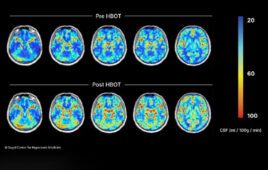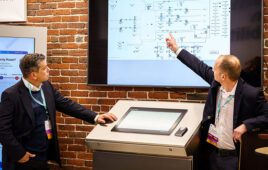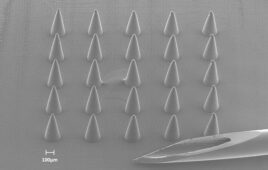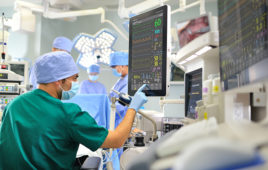If you were to ask doctors what the greatest challenges to healthcare were today, undoubtedly, you’d get a wide array of response. But it’s likely that more than a few would list shortages of blood among their answers.
Our blood is…well, quite literally, the “lifeblood” of our bodies. It is responsible for so many vital aspects of our health and well being. This is exactly why shortages of it can create such a problem for people, such as not being able to have a surgical procedure. And in emergency or trauma situations, it can be the difference between someone living or dying.
As a result, when I heard of a potential solution to the shortages of donor blood, it certainly peaked my interest. I reached out to Walter E. Goldstein, Ph.D., PE, president of the Goldstein Consulting Company and the primary person behind an effort to develop artificial blood from stem cells. Although still in the R&D phase, Dr. Goldstein agreed to speak with MDT about his innovative process (without giving much away), and the impact it could make on healthcare.
Sean Fenske: Thank you for agreeing to an interview with MDT about your process of artificially creating Universal blood for the purpose of transfusion and to address other medical concerns. Before we speak about that technology, can you please briefly share your background in the development of medical technology?
Dr. Walter E. Goldstein: I’ve been involved with a number of projects and technologies in healthcare. These have included:
- Clinical diagnostics systems including prototypes for automated blood chemistry
- R&D on an alternative source material for an anti-cancer therapeutic
- DNA analysis methods and training systems for human identification
- Guiding development of QC methods for rDNA-based human blood coagulation agents
- Devising a chemical engineering analysis basis for diabetes monitoring and control
- Analysis methods used in clinical trials for analgesics
- Probiotics processes and products for application to health needs
- Investigation of solutions to irritable bowel syndrome based on chemical engineering
- Preventative measures and solutions in authored books for health challenges related to mold and contamination of the environment
- Conducting preparatory investigative research, gaining an issued patent over examiner challenges, and leading efforts to produce Universal Blood from stem cells to augment and replace donor blood
Fenske: Since that last item on your list is the one that caught my eye so as to reach out to you about doing this interview, can you please share some insights on your effort to artificially create red blood cells?
Dr. Goldstein: We need to demonstrate that our patent can be carried out to produce red blood cells consistently [the in vitro red blood cells (IVRBC) process] in order to receive grant funding and secure funding to advance our work. In addition, we need to show that methods can be developed to produce red cells from stem cells to meet economic targets through scale up based on chemical engineering principles and practices since there are doubts on the part of others that this can be done. The next step would be to apply large scale cell culture techniques to understand cell formation during hematopoiesis and maintain phenotype lineage to produce red cells. This is a major technical undertaking. I have years of experience carrying related products to commercialization that need to be translated to this situation. Of course, convincing parties to feel compelled to buy-in and support what we are trying to do as a breakthrough technology (in what has been a very traditional business) is very challenging.
Fenske: Did you develop the technology that’s used for this process?
Dr. Goldstein: All matters as covered in our patent present novel ways to make the red cells and unique ways to provide oxygen and remove carbon dioxide. The process described is novel and very scalable. This has to be demonstrated in research and development.
Fenske: From where are you getting the stem cells for this process?
Dr. Goldstein: Stem cells of the correct starting phenotype will be secured from industry and medical parties with whom we have and are developing relationships.
Fenske: How would this blood compare to actual human blood for transfusion?
Dr. Goldstein: It is expected to be a natural replacement for Universal blood (Type O negative) given the process is carried out and product formed as covered in our patent. This has to be experimentally demonstrated and validated through testing.
Fenske: Could this process be used to delivery drugs into the blood stream more efficiently?
Dr. Goldstein: It is possible if the drug can be transported into the red cells, remain there stably, and shown to be exported to selective regions in vivo for therapeutic benefit. The drug could also be introduced prior to the stage of red cell formation if this can be done without interfering with cell expansion and then differentiation that occurs during hematopoiesis.
Fenske: Recently, I wrote up an item that discussed the differences between young and old blood. Does this blood resemble the characteristics of either?
Dr. Goldstein: This is an interesting idea. Our blood will be fresh and plentiful from bioreactors once our process is developed and scaled up. This should be considered new, unaged blood. Type O negative Universal blood is expected to have attributes that are consistent with the article you shared.
Fenske: What are some of the other applications for artificial blood beyond transfusion?
Dr. Goldstein: Evidence in the literature indicates that special transfusions can be used to correct diseases of many kinds. One being investigated, and in use clinically, is to transfuse fresh blood cells to treat sickle cell anemia as a temporary remedy.
Research to be conducted in the development of the IVRBC process will increase understanding of red cells (and their precursors) and the configuration changes undergone by hemoglobin in the red cells during oxygen and carbon dioxide binding and release. Various molecules are involved in changes in hemoglobin configuration. Our research will lead to a better understanding of these phenomena since that will be essential to understanding the oxygen (and carbon dioxide) transfer and binding process.
The oxygen and carbon dioxide transfer is controlled by hemoglobin binding and release, as well as external mass transfer events. Our work will provide enhanced understanding of this transport for red cells and those cells that precede red cells in the hematopoiesis pathway. Our patent shows (in part) how oxygen and carbon dioxide transfer can be improved. This understanding is expected to carryover to clinical applications that depend on such transfer to maintain elevated oxygen concentration. This may have implications in COPD, for example. It is a matter of determining where the transport resistance to oxygen and carbon dioxide transfer lies in different applications. This is a good example of applying chemical engineering to improve hematology.
Fenske: What are the greatest challenges with developing artificial blood?
Dr. Goldstein: As covered in our patent, demonstrating that stable cells can be maintained during hematopoiesis leading to red cells of the correct phenotype for Universal blood.
Also, showing that the productivity needed can be attained in order to lead to development of a process and product with acceptable economics.
Convincing the blood collection supply and use organizations (and their support groups) that this product can be an excellent addition to the donor blood product lines based on alleviation of shortages and absence of diseases that periodically cause concern is another challenge.
Finally, gaining sufficient interest and financial support to fund the project through research, stages of scale up, and clinical trials. We hope this solution will receive fast track status due to how critical the project is.
Fenske: What’s the next step for this technology process?
Dr. Goldstein: Gain funding to proceed. This can include funds derived from licensing our patent and earmarked to support research in order for this to go forward.
Fenske: Before we close, any other comments you’d like to share?
Dr. Goldstein: As noted, this project has tremendous social and financial possibilities. I believe it is imperative that it be done to protect our nation and people everywhere. At my presentation last October, my first slide asked “What will you do to protect the blood supply for your loved ones?”




